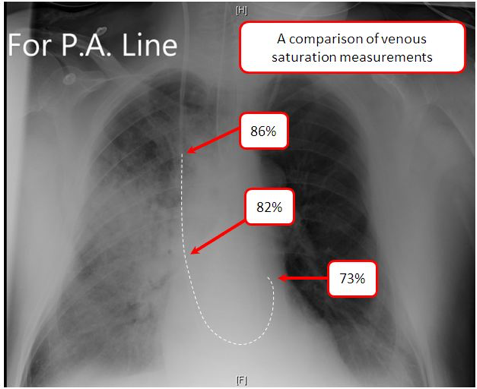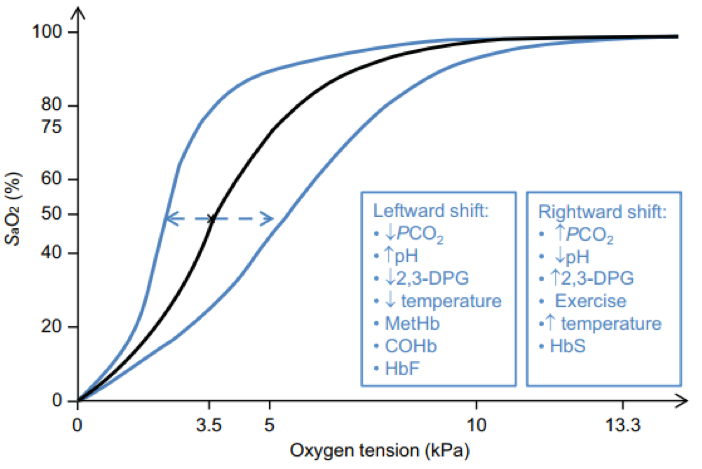G4vii / 21B13: Describe the factors that affect mixed venous oxygen saturation
21B13: Exam Report
Describe the factors that affect mixed venous oxygen saturation
49% of candidates passed this question.
Mixed venous oxygen saturation is used as a surrogate marker for the overall balance between oxygen delivery and oxygen consumption. A good answer stated this, described the importance of where it is measured and went on to describe the various factors that affect oxygen delivery and consumption.
Descriptions of the factors that affect oxygen saturation of haemoglobin, partial pressure of oxygen in the blood and position of oxygen-haemoglobin dissociation curve were necessary to score well. Important omissions were factors that increased and decreased oxygen consumption.
While many candidates were able to correctly write the equations for oxygen content and oxygen flux, they then failed to
describe how the variables within these equations were related to mixed venous oxygen saturation.
G4vii / 21B13: Describe the factors that affect mixed venous oxygen saturation
Definitions
Mixed venous blood
Blood taken from the pulmonary artery (e.g. by a pulmonary artery catheter)
- Blood from the IVC, SVC & Coronary sinus are mixed in the RV
- Representative of the oxygen extraction for the entire body
- Mixed venous oxygen saturation = SvO2
- Normal SvO2 = ~75%
- Normal PvO2 of mixed venous blood = ~40mmHg
Mixed central venous blood
Blood taken from the SVC (e.g. by an internal jugular or subclavian CVC)
- Mixed central venous oxygen saturation = ScvO2
- Normal ScvO2 = ~70%
- [CICM] Blood taken from the IVC via a femoral CVC does NOT count as a mixed central venous oxygen saturation
SvO2 compared to ScvO2
There is disagreement about whether the SvO2 or the ScvO2 (from the SVC) is higher – in summary it depends on the state of the patient
[LITFL]
In a patient at rest, the mixed venous oxygen saturation (SvO2 from the PA) is usually HIGHER than ScvO2 (taken from the SVC), due to:
- The blood in the SVC having lower oxygen saturation as the brain has the highest oxygen extraction ratio of the major organs at rest
- The blood in the IVC having higher oxygen saturation as the kidneys have the lowest oxygen extraction ratio, while having the largest blood flow → as a result this brings up the oxygen saturation in the pulmonary artery
[Deranged physiology]
In a patient at rest, the mixed venous oxygen saturation (SvO2 from the PA) is usually HIGHER than ScvO2 (taken from the SVC), due to:
- The blood in the SVC having lower oxygen saturation as the brain has the highest oxygen extraction ratio of the major organs at rest
- The blood in the IVC having higher oxygen saturation as the kidneys have the lowest oxygen extraction ratio, while having the largest blood flow → as a result this brings up the oxygen saturation in the pulmonary artery

[LITFL]
Other situations where SvO2 is lower than ScvO2 (SVC) include:
- Anaesthesia – due to ↑cerebral blood flow & ↓cerebral metabolism, thus ↓oxygen extraction
- TBI – due to ↓cerebral metabolism & ↓oxygen extraction
- Shock – due to diversion of blood away from splanchnic circulation + ↑oxygen extraction, thus ↓IVC saturation
There is also a difference in oxygen saturation for blood from the SVC vs IVC
- At rest, the SVC blood has a lower oxygen saturation (due to the brain having a high oxygen consumption) & the IVC having a higher oxygen saturation (due to the kidneys having a low oxygen extraction)
Oxygen content in mixed venous blood
Oxygen content in Mixed Venous blood (CvO2) = 1.34 x SvO2 x Hb + 0.03 x PvO2
PvO2 directly affects the proportion of dissolved oxygen as per Henry’s Law
SvO2 depends on the PvO2 & the oxygen-haemoglobin dissociation curve
In venous blood, the curve is slightly right–shifted (compared to arterial blood) because of the Bohr effect → ie in venous blood, the Hemoglobin has a REDUCED affinity for O2

Determinants of mixed venous oxygen saturation
Described by the components of the Fick equation, systemic oxygen consumption (VO2) is calculated from the Cardiac Output (CO) and the arteriovenous difference in oxygen content (CaO2 – CvO2):
- VO2 = CO x (CaO2 – CvO2)
- CO is the cardiac output in L/min
- VO2 is the oxygen consumption of the organism, in ml/min
- CaO2 is the arterial oxygen content in ml/L
- CvO2 is the venous oxygen content in mL/L
Thus the determinants for the oxygen saturation of mixed venous blood are:
Arterial oxygen content
- ↓ Arterial oxygen content = ↓mixed venous oxygen content
- O2 carrying capacity of blood – affected by the Oxygen-Haemoglobin dissociation curve
Cardiac output
- ↓CO = ↓mixed venous oxygen content
Systemic oxygen consumption (VO2)
- ↑VO2 = ↓mixed venous oxygen content
[Deranged Physiology]
From the Fick Equation, one can also derive that SvO2 ≈ 1 – ERO2
Steps to derive the above equation
Oxygen content in Mixed Venous blood (CvO2) = 1.34 x SvO2 x Hb + 0.03 x PvO2
PvO2 directly affects the proportion of dissolved oxygen as per Henry’s Law
1. Start with

2. Re-arranging:

3. Dividing both sides by DO2

4. Re-arranging:

Note!
Although SaO2 & SvO2 are NOT equal to oxygen content, but they are closely related
In ICU, SaO2 is kept fairly constant between 90-100% -> thus SaO2 can be ignored.
- Therefore, SvO2 = 1 – ERO2